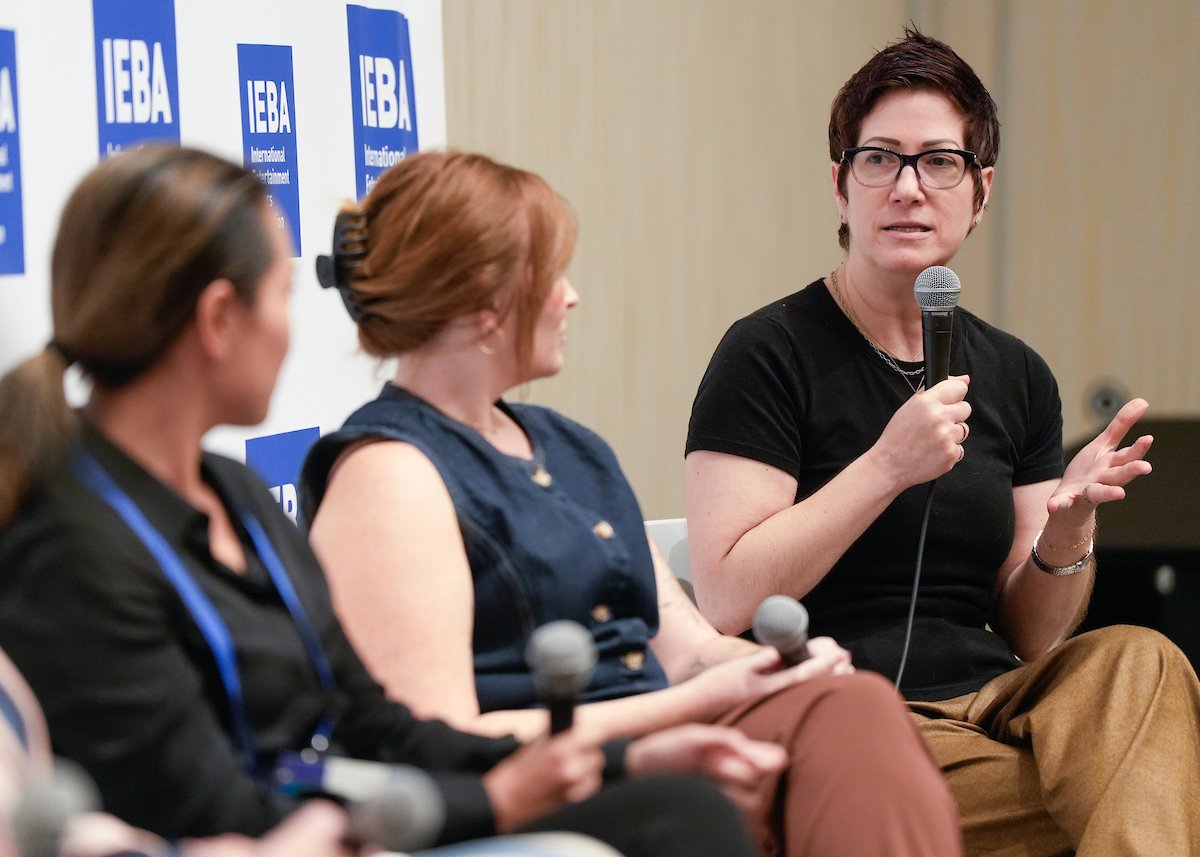UNLOCKING TICKET DISCOVERY FOR FANS WHERE THEY SCROLL
Panelists:
Annie Flook, AXS
Chrissy Hall, Ryman Auditorium & Grand Ole Opry House
Jamie Loeb, Nederlander
Betty Tran, FEVO
Moderated by: Kate Girotti, Legends Global
Sponsored by Bauer Entertainment Marketing
“Fans aren’t going to one place to buy tickets anymore,” opened Annie Flook (AXS). “They expect shows to be spoon-fed to them where they already are—on their phones. We have to meet them there, whether that’s Spotify, TikTok, or secondary marketplaces where they actually search.”
“Marketing shows has completely transformed,” said Jamie Loeb (Nederlander). “In the old days, it was print, radio, TV, and flyers. Now it’s precision targeting and custom audiences. Every show has its own data plan—geo-targeting, demographic filters, lookalikes. It’s smarter and more effective but way more complex.”
“FEVO is about meeting buyers where they are,” explained Betty Tran. “Whether that’s social media, creators, or retailers like Costco and Sam’s Club—we power those tickets. Social to us means FOMO and community. Fans share links with friends, and we track who actually converts. That’s real influence, not just paid influence.”
Chrissy Hall (Ryman Auditorium & Opry House) said her team relies on artist-driven platforms. “Most fans follow the artist, not the venue. So we prioritize Bandsintown and Spotify’s ‘On Tour’ integration—where fans already listen and discover. Our job is to make sure the Ryman is there when they do.”
Fighting the Secondary Market — and Using It
“The scale of the secondary market is staggering,” Flook said. “One company spent nearly a * billion dollars* on marketing last year. Ninety-two percent of fans Google ‘artist + tickets + city,’ and half don’t know they’re buying resale.”
Chrissy Hall added, “When you Google ‘Ryman Auditorium,’ our official site is often fourth or fifth. We can’t outspend them. So we build our database, email fans directly, and keep our social presence strong.”
Flook shared how AXS developed AXS Distro and AXS Anywhere to fight back. “We put primary tickets into those marketplaces so fans see the real price first. It undercuts bad actors and uses their massive ad spend to our advantage.”
Jamie Loeb agreed. “On a New Year’s show we listed through Distro, sold out the room, and forced scalpers to chase our pricing down. They lost margin and we kept control. That’s a win.”
Education remains key. “Fans see a $1,500 ‘$50 ticket’ and blame us,” Hall said. “We have to teach them to look for the right link. Half the problem is misunderstanding how our industry works.”
Pricing, Discounting & Dynamic Strategies
“All-in pricing changed everything,” Loeb said. “In California, the price you see is the price you pay—but we never educated fans about it. They think tickets just got more expensive.” She added, “Agents now ask, ‘If we price this at $89, what does the buyer actually see?’ That has to be part of the conversation from the start.”
Loeb also warned against last-minute discounting. “If you train fans to wait, they’ll wait. Reward early buyers instead with an early-bird tier. Then if you need a discount later, match that price point.”
Betty Tran noted that retail partners like Costco and Sam’s Club require a 20% minimum discount but deliver massive reach. “Costco has over 100 million members. That’s member value marketing—high volume, new audiences.”
Looking ahead, Loeb said, “Our industry needs to embrace dynamic pricing like airlines and sports. We’re the only sector that discounts when we’re not selling. That has to change.”
Social Strategy & FOMO as a Sales Tool
“Social is not just TikTok, Facebook, and Instagram,” Tran said. “It’s creating that FOMO moment—fans posting their purchase link, friends joining them. That’s organic growth you can measure.”
Loeb agreed: “We can get cute with skits and content, but it’s really about relationships. Fans want to feel seen. Mix sales posts with history, artist milestones, crew stories—put a human face on the brand.”
Chrissy Hall said the Ryman treats social as conversation, not commerce. “Our building has a voice. We post history, backstage moments, crowd shots—then a show plug fits naturally. If you just yell ‘buy tickets,’ people tune out.”
Loeb added that TikTok has been surprisingly effective for heritage artists. “Gen Z knows the song from a sound clip but not the artist. Connect the two—‘that TikTok song you love, that’s this artist at this venue’—and it converts.”
Fan Experience & Frictionless Buying
Fans expect a one-click journey, but fraud complicates it. “Every extra step loses someone,” Tran said. “Yet if we remove all the checks, the bots win.”
Flook outlined AXS’s tools: Fair AXS and AXS Anywhere. “Fans pre-register with a card so we can verify them and invite real buyers first. Every ticket for one recent tour sold through Fair AXS—and fans went on TikTok to celebrate how easy it was. It’s sad that ‘good ticketing experience’ is newsworthy, but that’s where we are.”
Security and fairness matter. “We use ID.me verification,” Tran added. “If a purchase is made outside your usual location, you get a text to confirm. It keeps chargebacks low and fans protected.”
Ultimately, said Carrasquillo (UTA), “Fans want a fair shot. They want to know they’re competing with other fans, not bots.”
Data, Education & Collaboration
Email is not dead, Loeb insisted. “Your database and socials are your lifelines. Email drives sales if you use it right—low-ticket alerts, fan reminders, exclusive presales. Own your data and you own your audience.”
Panelists encouraged cross-pollination: upload past buyer lists to Meta to create custom audiences and lookalikes, then target those who haven’t bought for the current tour. “Your ticketing data, social data, and promoter data should work together, not in silos,” Hall said.
Education was a recurring theme. “We need fans to understand how pricing and fees actually work,” Flook said. “They don’t realize that a $70 ticket on a secondary site can cost $200 with fees—and none of that extra goes to the artist or venue.”
Takeaways
• Meet fans where they scroll—Spotify, TikTok, Bandsintown, creators, and retail.
• Use the secondary market strategically—place primary tickets there at face value to fight scalpers.
• Price from the buyer’s perspective—be transparent about all-in costs.
• Reward early purchases—avoid training fans to wait for discounts.
• Use social to connect, not just sell—relationships create FOMO and loyalty.
• Balance friction and security—protect fans without adding obstacles.
• Own and activate your data—email and custom audiences still drive conversion.
• Educate the consumer—teach fans to click the right link and understand value.
Moderator Kate Girotti closed: “Fans are scrolling in a thousand places. If we want them in our rooms, we have to show up in their worlds first.”





